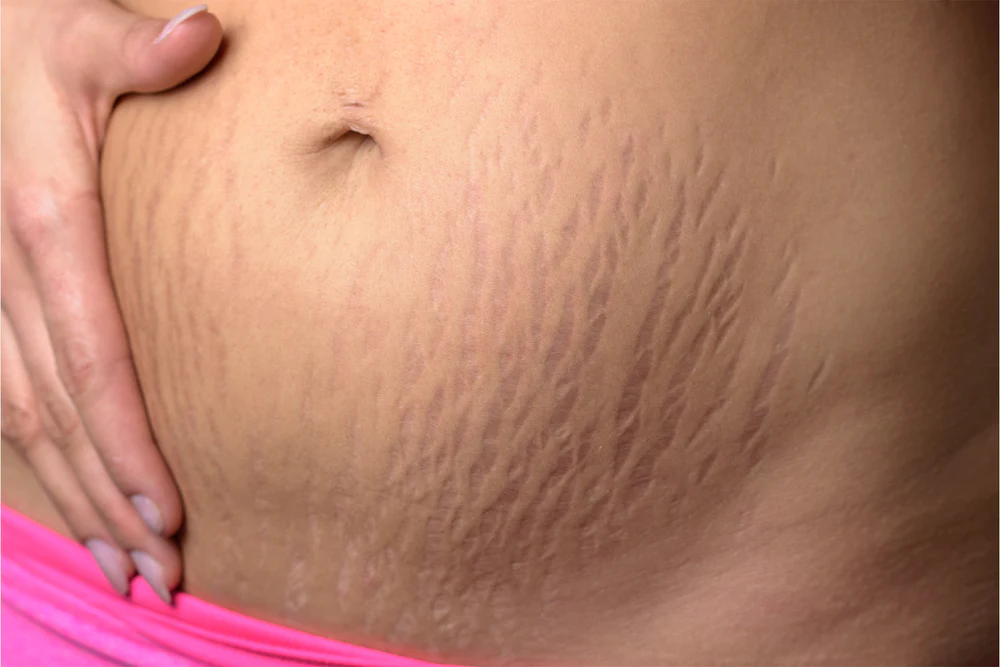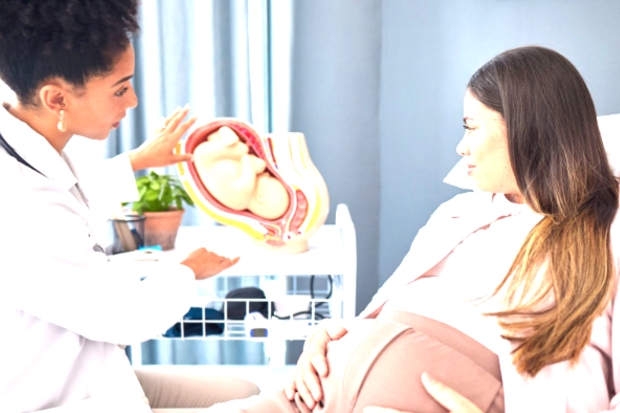Having a baby is one of life’s greatest blessings; there’s nothing quite like looking down into your little one’s eyes and promising to love them forever. That being said, there are some parts of being pregnant and creating this precious baby that is completely normal yet can be quite frustrating at times.
Pregnancy comes with all sorts of new body experiences. Your bladder control becomes basically non-existent, and perhaps your favorite shorts no longer fit. Additionally, you may start to develop a few lines called stretch marks.
We are going to discuss everything about stretch marks and go over what can be done to potentially help them fade if you’re looking for a plan. Keep reading to learn about the ins and outs of stretch marks.
What Is a Stretch Mark?
A stretch mark is a scar in the form of parallel lines that appear on the skin. Stretch marks are also known as striae distensae. Stretch marks are very common and are nothing to be ashamed of. Stretch marks can appear on both men and women. They can appear on adults and children.
Stretch Marks: Why They Appear
Stretch marks appear on your skin when your skin rapidly stretches or shrinks. This could be caused by rapid weight gain or weight loss. When your skin changes so rapidly, the elastin and collagen can become ruptured, thus creating a stretch mark.
Stretch marks are especially common in pregnant women. When a woman is pregnant, she gains weight, and her skin stretches faster than it would typically.
Sometimes you can go through your whole pregnancy without a stretch mark but then get them shortly after giving birth. This is because the loss of baby weight happens so fast.
Going through pregnancy is not the only way someone can get stretch marks. Stretch marks can come from something as common as a growth spurt.
You may notice a new stretch mark without any noticeable weight changes. Sometimes they can come without warning from changes you did not see. Stretch marks typically appear on parts of the body such as the stomach, breasts, thighs, buttocks, and upper arms.
Stretch marks can be itchy or even sore sometimes. Some women may experience discomfort when new stretch marks pop up. It’s best to avoid scratching at the stretch marks if they are itchy, as this can cause additional pain and redness. Have a chat with your healthcare team if you’re feeling uncomfortable; they can help find you a solution.
Stretch marks tend to vary in appearance. A big factor in the appearance of stretch marks is your skin tone and skin type. Stretch marks can be red, purple, or even pink. When you put your finger over them, these marks can feel raised and sometimes bumpy.
Stretch Marks Outside of Pregnancy
Certain medical conditions may be associated with the development of stretch marks. One of those medical conditions is Cushing’s syndrome. Other symptoms of Cushing’s syndrome may include bruising easily, muscle weakness, and redness of the face. Talk to your doctor if you have any concerns.
Can Stretch Marks Be Prevented?
Stretch marks are a sign of your strength! Carrying a baby is no joke — your body is doing something amazing!
While we know our stretch marks are tiger marks, a sign of our accomplishments, sometimes we’d prefer if they were just a little lighter.
Although we cannot completely prevent stretch marks from happening in many/most cases, we can take measures to potentially reduce the number of stretch marks we can get.
(Genetics also play a part in how susceptible we may be to stretch marks. The more stretch marks our family members get, the more we may be susceptible to.)
How Long Does It Take for Stretch Marks To Fade?
Although there may not be a way to make stretch marks go away altogether, they do begin to fade. Some may fade so much that they are barely noticeable.
When stretch marks first appear, they can be very vibrant and noticeable, but after some time, stretch marks can begin fading and becoming less noticeable. This fading does not happen overnight; it can take quite a bit of time. Make sure to be patient when waiting for your stretch marks to fade.
There is no set timeframe for when your stretch marks will begin to fade. This can range from anywhere between six months to over a year. The fading of stretch marks depends on your skin and how quickly your skin heals.
What Can Be Done To Help Stretch Marks Fade?
As we discussed, stretch marks do fade with time, but there are also small things that can be done to help speed up this process.
Look Into Home Remedies
There are some at-home remedies that are said to reduce the appearance of stretch marks. Make sure to be educated about all side effects before starting any stretch mark remedies. You’ll want to make sure that the ingredients within any of the products that you use are complimenting to your body.
These remedies include using certain topical products like aloe vera and coconut oil. You can rub these directly on the stretch marks. Such all-natural oils may help with irritation and the appearance of stretch marks.
Another at-home remedy for fading stretch marks at a faster rate is using vitamin A skin care products. Vitamin A skin care products are also known as a retinoid. Be slow and cautious when using any kind of retinol products — to treat stretch marks or any other skin condition. Have a chat with your healthcare provider first.
A friend might have recommended self-tanning products — self-tanners won’t erase stretch marks but can make them a tad less noticeable.
Moisturize
It may help to keep up with self-care, including moisturizing. You can use over-the-counter lotions aimed at stretch mark prevention, such as cocoa butter. Cocoa butter can be found in just about every department store; you might have some in your kitchen cabinets right now!
You can also moisturize with some vitamin E oil, almond oil, or olive oil. All three of these are great for your skin and smell amazing too!
Hyaluronic acid is another substance that can be great for moisturizing and healing the skin. Hyaluronic acid can be found in certain lotions, serums, and creams. Recent studies show that hyaluronic acid may decrease the appearance of stretch marks.
Hydrate
It’s not only your skin that needs some love from time to time. Make sure to drink plenty of water while pregnant. Your body needs extra water to stay hydrated during this time to create more blood, amniotic fluid, tissue, and more.
Plus, staying hydrated can help improve skin health, including acne and stretch marks. After giving birth, hydrating can help produce breast milk for mothers who choose to go this route.
Visit Your Dermatologist
If you’ve tried a few home remedies and feel you’re at an impasse, it may be time to reach out to a board-certified dermatologist.
The study of dermatology focuses on skincare and how to get skin healthy — the perfect person to call! A dermatologist can provide some stretch mark products to soothe irritation or itchiness.
They can also recommend a few products like supplements or topical creams that can help reduce how prominent they are.
Review Cosmetic Procedures Carefully: Postpartum Care
There are quite a few avenues available. The ones below aren’t generally recommended for pregnant women. It’s advisable to wait until after giving birth and recovering from the postpartum period.
Two such stretch mark treatments in this category include micro-needling and laser therapy.
Microneedling is a cosmetic where the skin is pricked by tiny needles. This may sound painful, but there really shouldn’t be much pain at all. In micro-needling, the small wounds help the body produce more collagen.
Collagen can help improve skin health: More collagen helps improve skin elasticity. When the skin has more elastin, stretch marks are less likely.
Other women may opt for laser treatment to reduce their stretch marks. Laser therapy penetrates the skin and gets collagen to produce more rapidly.
Conclusion
Sometimes, change can be hard, especially when we’re talking about changes to our bodies, but let’s not let stretch marks deter our self-confidence! Wear them with pride because your body is perfect just the way it is. Stretch marks are just another part of life that should be embraced.
Remember, you are always beautiful!
Sources:
Stretch marks – Symptoms and causes | Mayo Clinic
Management of stretch marks (with a focus on striae rubrae) | PubMed












